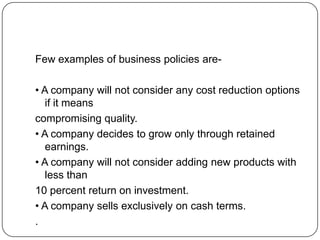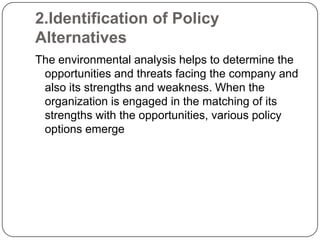Business policy
- 1. BUSINESS POLICY Chandra Shekhar Pandey
- 2. Business policy is study of the function and responsibility of Senior Management. The crucial problems that affect the success of the in the whole organisation and the decisions that determine the direction of the organisation and shape its future.
- 3. A policy is typically described as a principle or rule to guide decisions and achieve rational outcome(s).Policies are generally adopted by the Board of or senior governance body within an organization where as procedures or protocols would be developed and adopted by senior executive officers.
- 4. Few examples of business policies are• A company will not consider any cost reduction options if it means compromising quality. • A company decides to grow only through retained earnings. • A company will not consider adding new products with less than 10 percent return on investment. • A company sells exclusively on cash terms. .
- 5. • A rental company charges a deposit for rented material. • A rental car company charges extra money for delivering the rented car in another location. • A company hires personnel with experience only. • A company prepares guidelines on how to collect debts from its customers. • A company will not question customers’ returns of items purchased earlier. • A company responds to 50 percent of customer inquiries within three working days
- 6. Steps in policy formulation Environmental Analysis 2. Identification of Policy Alternatives 3. Evaluation of Policy Alternatives 4. Choice of Policy 1.
- 7. I) Environmental Analysis . There are basically two environmental factors: internal and external. The two together provide for identification of problem areas with respect to which the policies could be made
- 8. 2.Identification of Policy Alternatives The environmental analysis helps to determine the opportunities and threats facing the company and also its strengths and weakness. When the organization is engaged in the matching of its strengths with the opportunities, various policy options emerge
- 9. 3. Evaluation of Policy Alternatives .The evaluation of policies is known as policy audit. The alternatives can be evaluated on the basis of their consequences in terms of their contribution to corporate goals. Several criteria could be used for evaluation like growth, unit, profitability, development, organizational goals, etc.
- 10. 4.Choice of Policy The evaluation helps in the selection of the best possible policy. If any of the alternatives are not acceptable and not consistent with company’s objectives then the process reverts back to the identification of alternatives where fresh alternatives are looked for. The search begins again. After the policy has been made, it becomes necessary to review it from time to time so that it does not become obsolete.
- 11. TYPE OF POLICIES: Basically there are three main types of policies 1. Basic Policies:- These are framed by the top management and spell out the basic approach of a company to its activities and its environment. 2.General Policies:- These are framed by the middle level management and are more specific. They apply to large segments of the organization. 3.Specific Policies:- These are framed by the foremen and supervisors and are very specific in nature. They are applicable to routine activities.










